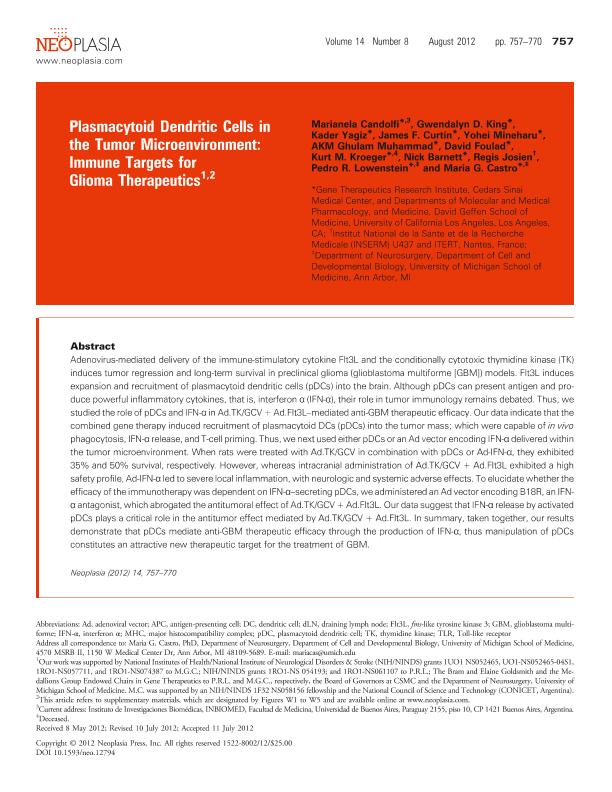Mostrar el registro sencillo del ítem
dc.contributor.author
Candolfi, Marianela

dc.contributor.author
King, Gwendalyn D.
dc.contributor.author
Yagiz, Kader
dc.contributor.author
Curtin, James F.
dc.contributor.author
Mineharu, Yohei
dc.contributor.author
Ghulam Muhammad, A.K.M.
dc.contributor.author
Foulad, David
dc.contributor.author
Kroeger, Kurt M.
dc.contributor.author
Barnett, Nick
dc.contributor.author
Josien, Regis
dc.contributor.author
Lowenstein, Pedro R.
dc.contributor.author
Castro, Maria Gabriela

dc.date.available
2019-01-04T13:23:50Z
dc.date.issued
2012-08
dc.identifier.citation
Candolfi, Marianela; King, Gwendalyn D.; Yagiz, Kader; Curtin, James F.; Mineharu, Yohei; et al.; Plasmacytoid Dendritic Cells In The Tumor Microenvironment: Immune Targets For Glioma Therapeutics; Neoplasia Press; Neoplasia; 14; 8; 8-2012; 757-770
dc.identifier.issn
1522-8002
dc.identifier.uri
http://hdl.handle.net/11336/67377
dc.description.abstract
Adenovirus-mediated delivery of the immune-stimulatory cytokine Flt3L and the conditionally cytotoxic thymidine kinase (TK) induces tumor regression and long-term survival in preclinical glioma (glioblastoma multiforme [GBM]) models. Flt3L induces expansion and recruitment of plasmacytoid dendritic cells (pDCs) into the brain. Although pDCs can present antigen and produce powerful inflammatory cytokines, that is, interferon α (IFN-α), their role in tumor immunology remains debated. Thus, we studied the role of pDCs and IFN-α in Ad.TK/GCV + Ad.Flt3L-mediated anti-GBM therapeutic efficacy. Our data indicate that the combined gene therapy induced recruitment of plasmacytoid DCs (pDCs) into the tumor mass; which were capable of in vivo phagocytosis, IFN-α release, and T-cell priming. Thus, we next used either pDCs or an Ad vector encoding IFN-α delivered within the tumor microenvironment. When rats were treated with Ad.TK/GCV in combination with pDCs or Ad-IFN-α, they exhibited 35% and 50% survival, respectively. However, whereas intracranial administration of Ad.TK/GCV + Ad.Flt3L exhibited a high safety profile, Ad-IFN-α led to severe local inflammation, with neurologic and systemic adverse effects. To elucidate whether the efficacy of the immunotherapy was dependent on IFN-α-secreting pDCs, we administered an Ad vector encoding B18R, an IFN-α antagonist, which abrogated the antitumoral effect of Ad.TK/GCV + Ad.Flt3L. Our data suggest that IFN-α release by activated pDCs plays a critical role in the antitumor effect mediated by Ad.TK/GCV + Ad.Flt3L. In summary, taken together, our results demonstrate that pDCs mediate anti-GBM therapeutic efficacy through the production of IFN-α, thus manipulation of pDCs constitutes an attractive new therapeutic target for the treatment of GBM. © 2012 Neoplasia Press, Inc. All rights reserved.
dc.format
application/pdf
dc.language.iso
eng
dc.publisher
Neoplasia Press

dc.rights
info:eu-repo/semantics/openAccess
dc.rights.uri
https://creativecommons.org/licenses/by-nc-sa/2.5/ar/
dc.subject
Glioblastoma
dc.subject
Plasmacyotid Dendritic Cells
dc.subject
Gene Therapy
dc.subject
Ifn-Alpha
dc.subject.classification
Otras Biotecnologías de la Salud

dc.subject.classification
Biotecnología de la Salud

dc.subject.classification
CIENCIAS MÉDICAS Y DE LA SALUD

dc.title
Plasmacytoid Dendritic Cells In The Tumor Microenvironment: Immune Targets For Glioma Therapeutics
dc.type
info:eu-repo/semantics/article
dc.type
info:ar-repo/semantics/artículo
dc.type
info:eu-repo/semantics/publishedVersion
dc.date.updated
2019-01-02T19:38:35Z
dc.journal.volume
14
dc.journal.number
8
dc.journal.pagination
757-770
dc.journal.pais
Estados Unidos

dc.journal.ciudad
Nueva York
dc.description.fil
Fil: Candolfi, Marianela. Consejo Nacional de Investigaciones Científicas y Técnicas; Argentina. Cedars Sinai Medical Center. Gene Therapeutics Research Institute; Estados Unidos
dc.description.fil
Fil: King, Gwendalyn D.. Cedars Sinai Medical Center. Gene Therapeutics Research Institute; Estados Unidos
dc.description.fil
Fil: Yagiz, Kader. Cedars Sinai Medical Center. Gene Therapeutics Research Institute; Estados Unidos
dc.description.fil
Fil: Curtin, James F.. Cedars Sinai Medical Center. Gene Therapeutics Research Institute; Estados Unidos
dc.description.fil
Fil: Mineharu, Yohei. Cedars Sinai Medical Center. Gene Therapeutics Research Institute; Estados Unidos
dc.description.fil
Fil: Ghulam Muhammad, A.K.M.. Cedars Sinai Medical Center. Gene Therapeutics Research Institute; Estados Unidos
dc.description.fil
Fil: Foulad, David. Cedars Sinai Medical Center. Gene Therapeutics Research Institute; Estados Unidos
dc.description.fil
Fil: Kroeger, Kurt M.. Cedars Sinai Medical Center. Gene Therapeutics Research Institute; Estados Unidos
dc.description.fil
Fil: Barnett, Nick. Cedars Sinai Medical Center. Gene Therapeutics Research Institute; Estados Unidos
dc.description.fil
Fil: Josien, Regis. Inserm; Francia
dc.description.fil
Fil: Lowenstein, Pedro R.. Cedars Sinai Medical Center. Gene Therapeutics Research Institute; Estados Unidos. University of Michigan; Estados Unidos
dc.description.fil
Fil: Castro, Maria Gabriela. Cedars Sinai Medical Center. Gene Therapeutics Research Institute; Estados Unidos. University of Michigan; Estados Unidos
dc.journal.title
Neoplasia

dc.relation.alternativeid
info:eu-repo/semantics/altIdentifier/doi/https://doi.org/10.1593/neo.12794
dc.relation.alternativeid
info:eu-repo/semantics/altIdentifier/url/https://www.sciencedirect.com/science/article/pii/S1476558612800091
Archivos asociados
